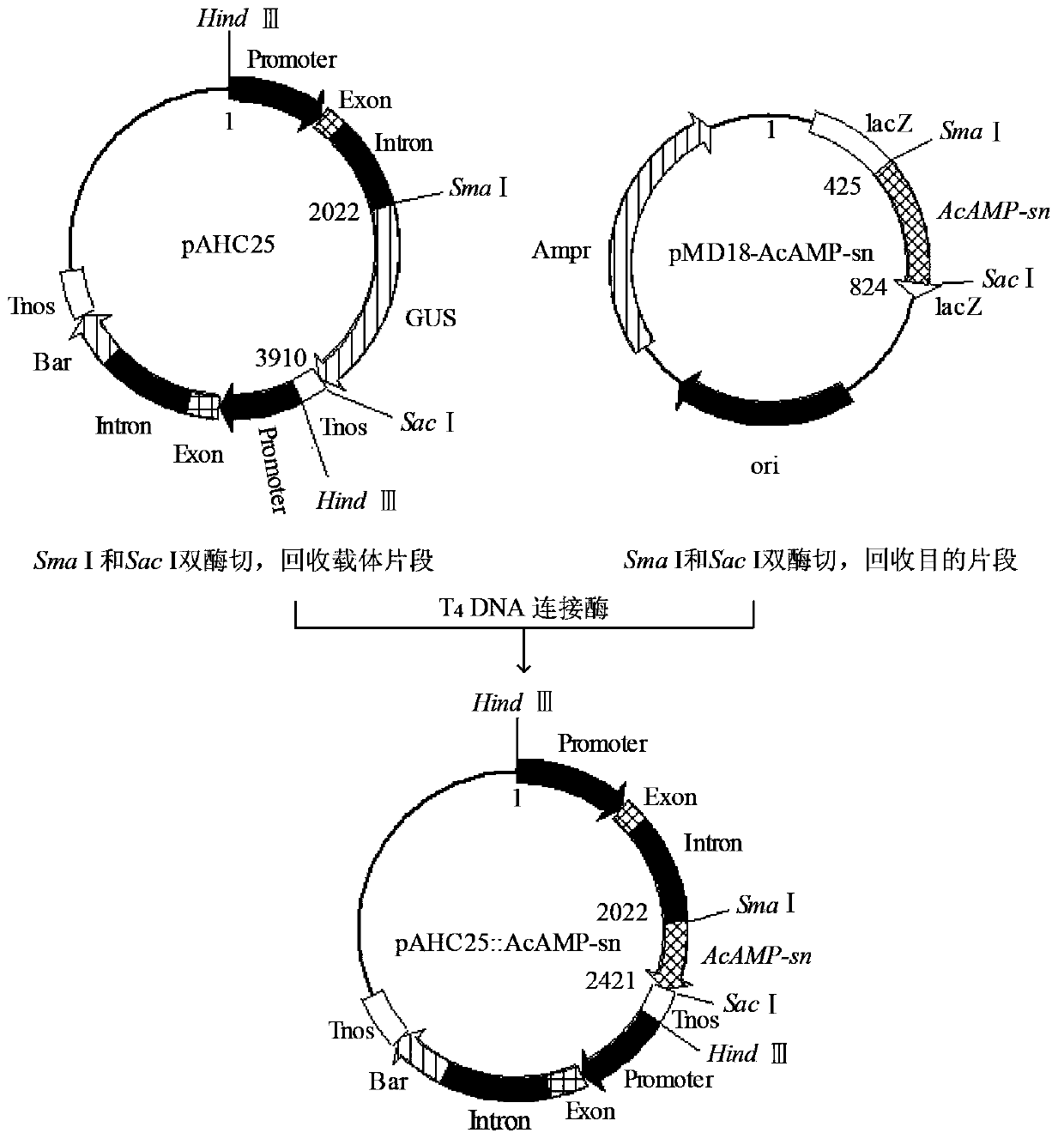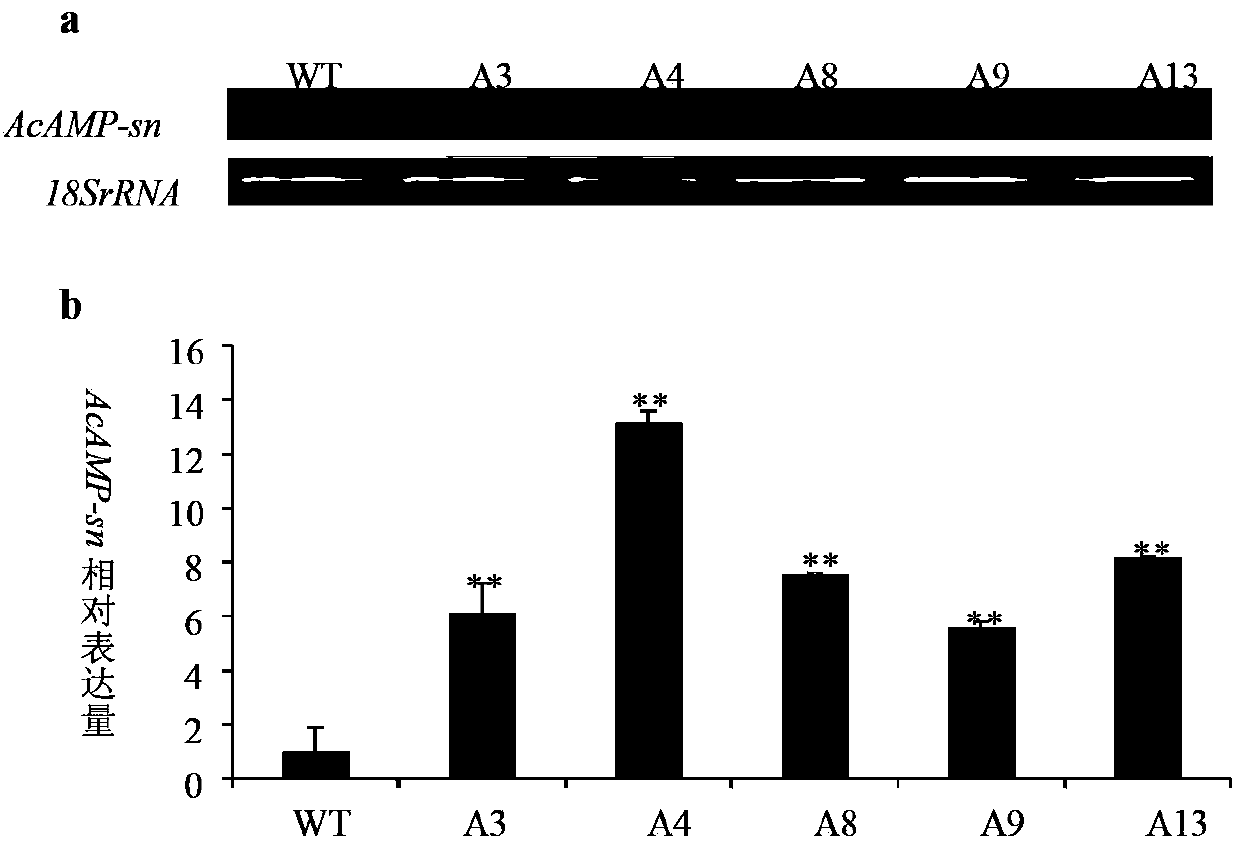Method for cultivation of transgenic wheat resisting take-all and sharp eyespot and related biological materials thereof
A technology for transgenic wheat and take-all disease, which is applied in botany equipment and methods, biochemical equipment and methods, genetic engineering, etc., and can solve problems such as poor resistance and slow breeding progress
- Summary
- Abstract
- Description
- Claims
- Application Information
AI Technical Summary
Problems solved by technology
Method used
Image
Examples
Embodiment 1
[0045] Embodiment 1, the acquisition of AcAMP-sn gene and the construction of recombinant expression vector
[0046] The coding sequence of AcAMP-sn gene was artificially synthesized, and the recognition sites of Sma I and Sac I restriction endonucleases were added at its 5' end and 3' end, respectively. The nucleotide sequence of the AcAMP-sn gene is shown in sequence 1 in the sequence listing, consisting of 411 nucleotides, and its coding sequence is shown in the 7th to 405th nucleotides of sequence 1 in the sequence listing, its encoding The protein sequence of the protein is shown as sequence 2 in the sequence listing, and consists of 132 amino acid residues.
[0047] The AcAMP-sn gene was connected to pMD18-T vector, the intermediate vector pMD18-AcAMP-sn was constructed, and cloned into Escherichia coli cells.
[0048] The intermediate vector plasmid pMD18-AcAMP-sn was digested with restriction endonucleases Sma I and Sac I, and the AcAMP-sn gene fragment was recovered....
Embodiment 2
[0049] Embodiment 2, the acquisition of transgenic AcAMP-sn gene wheat plant and its disease resistance analysis
[0050] 1. Acquisition of transgenic AcAMP-sn gene wheat plants
[0051]1. The young embryo callus of 1600 pieces of Yangmai 18 was used as the acceptor bombarded by the gene gun, and the recombinant plasmid pAHC25::AcAMP-sn of Example 1 was bombarded into the callus with the gene gun, and the specific method was as follows:
[0052] 1) The immature embryo callus of Yangmai 18 was osmotically treated on a high-osmotic medium (SD2 medium supplemented with 0.2mol / L mannitol and 0.2mol / L sorbitol) for 4-6h (25°C, dark culture) : the calli are placed within the diameter of about 2.5cm in the center of the petri dish, and 50 calli are placed in each petri dish. Among them, the formula of SD2 medium is MS medium + 1mg / L VB 1 +150mg / L asparagine +2mg / L2,4-D.
[0053] 2) The pAHC25::AcAMP-sn plasmid was used to wrap gold powder with a diameter of 1 μm, and the PDS-1000 / ...
PUM
 Login to View More
Login to View More Abstract
Description
Claims
Application Information
 Login to View More
Login to View More - Generate Ideas
- Intellectual Property
- Life Sciences
- Materials
- Tech Scout
- Unparalleled Data Quality
- Higher Quality Content
- 60% Fewer Hallucinations
Browse by: Latest US Patents, China's latest patents, Technical Efficacy Thesaurus, Application Domain, Technology Topic, Popular Technical Reports.
© 2025 PatSnap. All rights reserved.Legal|Privacy policy|Modern Slavery Act Transparency Statement|Sitemap|About US| Contact US: help@patsnap.com



